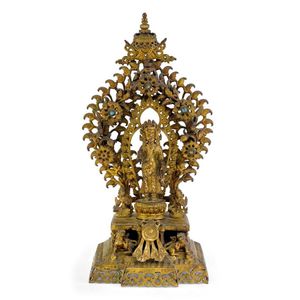Gilt Bronze Dipankara Buddha Figure with Mandorla and Lions
You must be a subscriber, and be logged in to view price and dealer details.
Subscribe Now to view actual auction price for this item
When you subscribe, you have the option of setting the currency in which to display prices to $Au, $US, $NZ or Stg.
- Tier - One or more under-shelves of a table or cabinet.
- Foo Dogs - Foo Dogs, also known as "Fo Dogs", "Fu Dogs", and " Buddhist lions" are the Chinese guardian lions that have traditionally stood in front of Chinese Imperial palaces and tombs, government offices, and the homes of the influential are believed to have powerful mythic protective benefits.
They are a popular motif in decorative arts, especially ceramics and garden statuary, where they are depicted in pairs, comprising of a male resting his paw upon an embroidered ball, representing supremacy over the world, and a female restraining a playful cub, representing the nurturing properties of the female. - Bronze - An alloy of copper and tin, traditionally in the proportions of about 9 parts of copper to 1 part of tin.
The discovery of bronze in Western Asia in the 4th century enabled people to create metal objects which were superior to those previoulsy possible because of its strength and hardness, and it has been used throughout the world for weapons, coins, tools, statuary and other decorative items.
It is very fluid in a molten state, and its hardness, strength when set, and non-corrosive properties makes it most suitable for casting sculpture.
This item has been included into following indexes:
Visually similar items

A large gilt metal seated Buddha on stand. Flanked by two attendants. Stand of floral form with gallery base. Height 69 cm

Bali, figure of Padmapani, possibly 12th century, bronze Bodhisattva with parasol seated on a round throne incised with rectangles and floral scroll. One leg crossed and right leg outstretched with open palm resting on knee. The figure is seated in the pos

A Chinese gilt bronze Buddha, double-vajra mark to the base, 28.7 cm high

A gilt bronze figure of eleven-headed avalokiteshvara, 18th century or later, cast standing on a double lotus base with eight arms and eleven heads arranged in four tiers, the principle hands in anjalimudra, the others fanned out, one holding a lotus flowe
